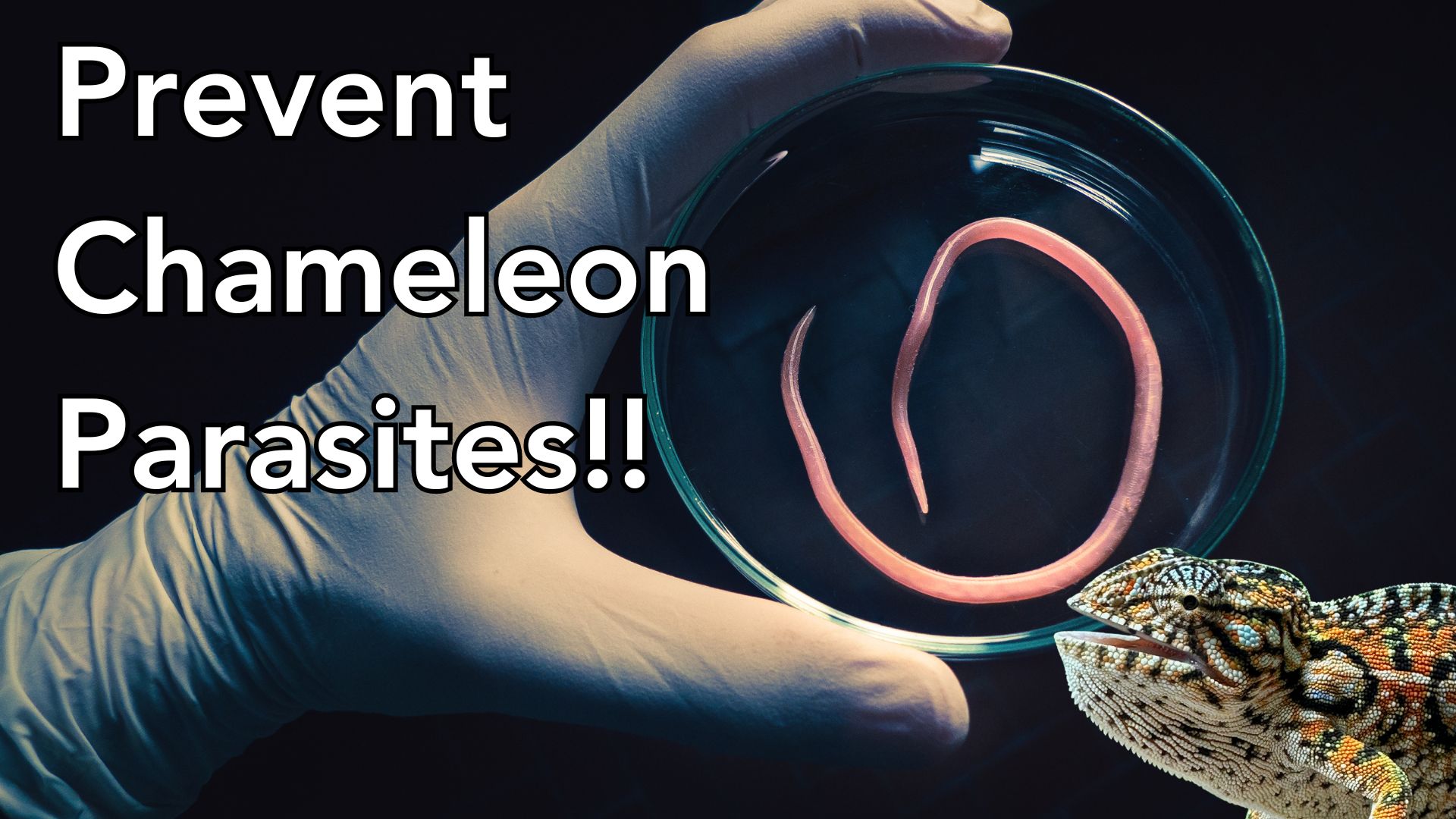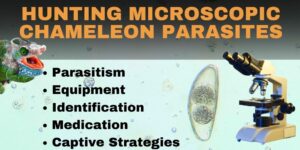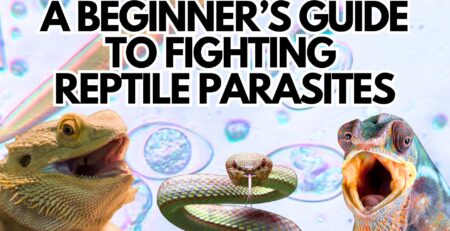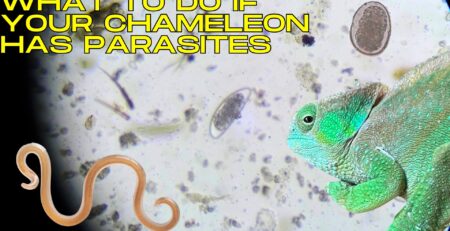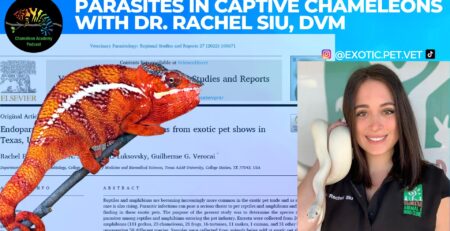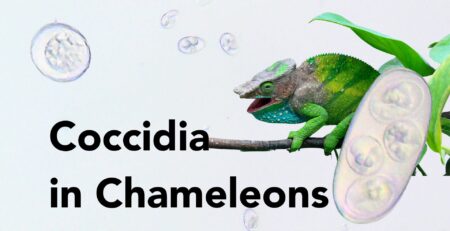How to prevent chameleon parasites
The best chameleon husbandry strategy is to never have parasites. No surprise there! But you might be surprised at how easily your chameleon could end up with parasites this far from Madagascar. Let’s go over ways that you can stack the odds in favor of you not having to deal with parasites.
Video Player
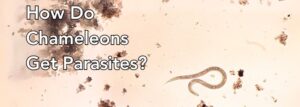
How do chameleons get parasites?
Parasites generally infect a chameleon by either the oral route or through blood sucking invertebrates. Whether certain nematodes, like hookworms, can enter through the skin as they do with humans and dogs is still to be determined. There is thought that there might be a dynamic called “vertical transmission” which would be the parasites being transmitted from the mother to the egg or baby during egg laying or giving birth. This, again, is hypothesized, but I am not yet aware of a documented example.
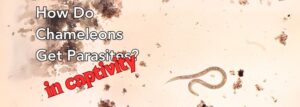
How do chameleons in captivity get parasites?
In captivity we focus primarily on the oral route of entering into the chameleon’s body. Because we use fine mesh for our cages, mosquitoes and other blood suckers, generally, do not have access to your chameleon.
The parasites with a direct lifecycle that involves going in through the mouth, though, is greatly favored in the captive environment. This is because they are expelling enormous amounts of infectious ova (eggs), cysts, and oocysts through the poop. Evolutionarily, they expect most of these to die without ever getting near the next chameleon definitive host. But when a chameleon definitive host is trapped in a small area with the poop and we add perfect vectors in the feeding insects we raise the parasite threat level to the critical stage.
The chameleon parasites are working to find their way to your chameleon even this far away from Madagascar. Coccidia oocysts, for example, can live in their infectious state in the environment for more than a year. So, you may wonder how your new chameleon got a parasite. Did you buy it at a reptile show or a reptile shop? Did you buy it from a breeder who just returned from a reptile show? Did you go to a reptile show a year ago and turned a door knob that someone who held a wild caught chameleon turned right before you got there? As disturbing as it is, you could easily have brought coccidia oocysts from that show a year ago back to your home and they could be waiting for a chameleon to arrive. We chameleon keepers need to realize how good these parasites are at getting back to a chameleon. Of course, the ova and oocysts do not have brains of their own. So they aren’t scheming to ambush you or your chameleon. No, they just create an overwhelming number of ova and oocysts so they blanket the area as much as is possible. This raises the odds of at least one or two of the eggs to make it where they need to go. A parasite’s life is like us playing the lottery. The odds against one ticket winning are astronomical. But if you buy one million tickets the odds start to get better. Parasites overcome these odds by creating a vast number of eggs and infectious material.
How to prevent parasites from infecting your chameleon
The more you know about the parasite lifecycles the better you will know how to break that lifecycle in multiple places. Even if you don’t dive deeper into research, these five steps are highly effective to preventing chameleon parasites.
- Do not buy a wild caught chameleon
- Keep chameleons individually
- Get a routine chameleon fecal check once a year
- Practice parasite level spot cleaning every day.
- Be mindful of what you touch and wash your hands often
I will explain each one of these.
Do not buy a wild caught chameleon
Wild caught chameleons will come in with a natural parasite load. Even though captive bred chameleons often have parasites, they may not have the diversity and the intensity of parasitic infection as a wild caught chameleon. Either way, a wild caught chameleon is almost guaranteed to come in with parasites and so any money you saved by buying a wild caught chameleon will evaporate quickly in the veterinarian bills to eliminate the parasites.
Leave wild caught chameleons to the breeders who are needing diverse bloodlines for genetic health. If at all possible, get a captive bred chameleon.
Keep chameleons individually
Any chameleon living in the same space as another will be sharing parasites. Group keeping is incorrect husbandry to begin with for many different reasons so keeping chameleons together shouldn’t even be considered. But, there are times, such as during mating, that contact is required. Be mindful that this could share parasites and make sure both have tested negative for parasites before introducing them.
Get a routine chameleon fecal check once a year
Even when you are keeping the best cleanliness practices, parasites have a way of infiltrating your home. Thus, you want to set up a system where you will check and verify whether any parasite has slipped through. The more frequent the fecal check the better. I do fecal checks on my chameleons every poop. But, if you are not able to do your own chameleon fecal check, then have your vet do one at least every year. You can increase the frequency if you go to reptile shows, interact with other people in the reptile community, or bring in new chameleons to the household.
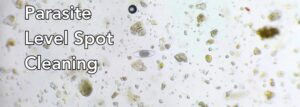
Parasite Level Spot Cleaning
A critical part to the parasite lifecycle is getting the infectious material, the eggs and cysts, from the feces to the chameleon’s mouth. Your job is to remove any infectious material. This means that when a poop hits the ground it is removed and disinfected as soon as possible. My method of spot cleaning chameleon poop is as follows:
- Use a dry paper towel to wipe up as much of the feces as possible and throw it away. If I have any suspicion that there may be parasites involved I wear a disposable glove while doing this step and I peel the glove off my hand in a way that everything I picked up is now contained within the inside out glove.
- Spray disinfectant on the area. I prefer accelerated hydrogen peroxide (Brandname: Rescue) or a quaternary ammonium (Brandname: F10) and let sit for the amount of time dictated by the bottle instructions. Ensure there are no fumes that can harm your chameleon.
- Wipe up disinfectant with a dry paper towel
- Remove any last residue of the disinfectant with a moist paper towel
- Do one last round of wiping everything dry with a dry paper towel.
Note: The Amazon links to the products above are affiliate links and purchasing from them supports the Chameleon Academy outreach
Be mindful of what you touch and wash your hands often
Your hands are the best transport parasites have into your chameleon’s cage. To prevent parasites from finding your chameleon you must be obsessive about knowing what you are touching. Just to put it in perspective, coccidia oocysts can live for over a year in the environment just waiting for the signals that they have been ingested by a chameleon. So, if you have been to a reptile show or a reptile store or any pet store in the last year you could have been exposed to oocysts and have brought them home. Even if you didn’t touch any reptiles, if you touched any surfaces after someone who touched reptiles, you are now transporting what they had on their hands. But, you say, you were very careful to wash your hands before leaving. Was the bathroom sink faucet a lever or a knob that you turned? If it was a turn knob then you deposited oocysts when you turned it on and then picked those oocysts back up on your clean hands when you turned the water off. This is exactly how oocysts have survived and have been successful spreading so well! You, literally, could have coccidia in your home before your chameleon gets there simply from your research phase.
This isn’t meant to make you panic. Just be aware of the magnitude of our challenge involved with preventing chameleon parasites!

Can we win the fight against chameleon parasites?
The first thing to come to terms with is that our fight with chameleon parasites is not a single event. It is a management action that spans the life of the chameleon. This is not an easy battle. Any place there are chameleons there will be parasites.
We definitely should focus on preventing parasites in the first place. But that should be only one facet of the war. It is your knowledge about the parasite lifecycle and your day to day hygiene and husbandry that will be the best block to parasites ever taking hold if they do breach your defenses.
In the war against parasites, the more you know, the better you are able to fight them. If you would like to have an in-depth training on how to perform fecal analysis at home to be able to check yourself, the Chameleon Academy offers a digital course, Hunting Microscopic Chameleon Parasites. This course assumes no prior knowledge and will lead you through parasite basics, getting your own microscope, learning how to set up your slides, and how to identify parasites. You will get an understanding of the medications, how to do an effective quarantine, and learn enough to be able to be an educated partner with your veterinarian for your chameleon’s health. If you are interested in this training you can find more information here:

